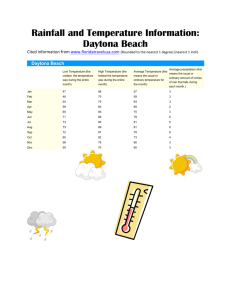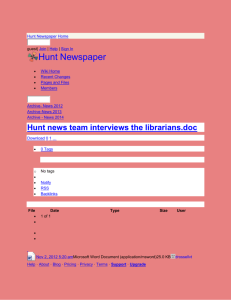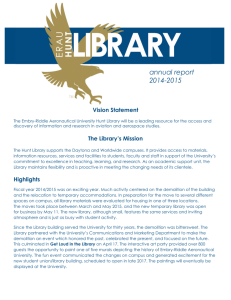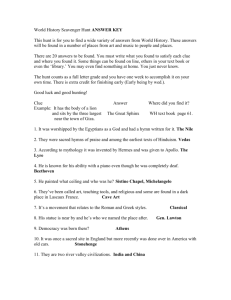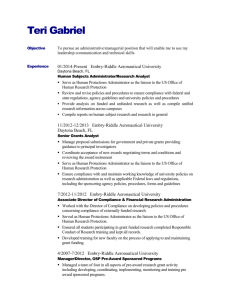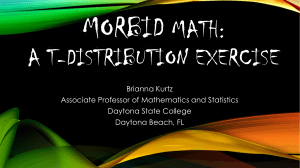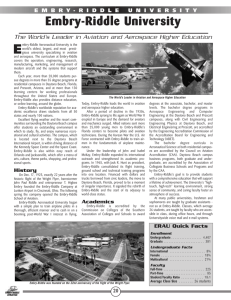Complete 2010-2011 Strategic Plan - Hunt Library - Embry
advertisement
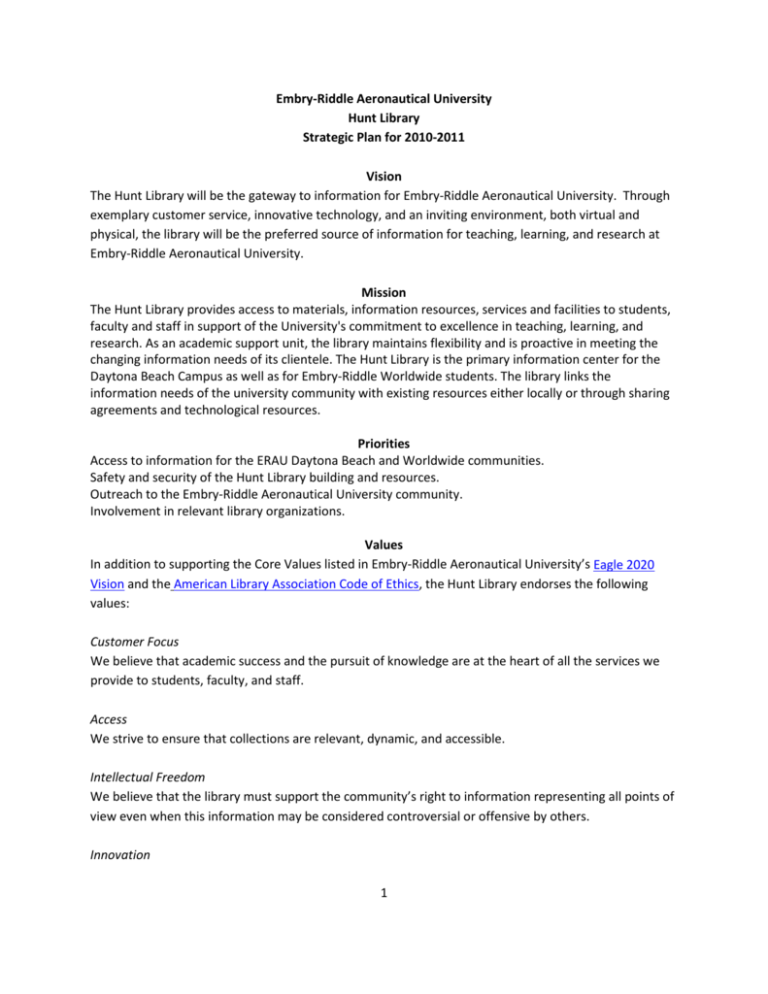
Embry-Riddle Aeronautical University Hunt Library Strategic Plan for 2010-2011 Vision The Hunt Library will be the gateway to information for Embry-Riddle Aeronautical University. Through exemplary customer service, innovative technology, and an inviting environment, both virtual and physical, the library will be the preferred source of information for teaching, learning, and research at Embry-Riddle Aeronautical University. Mission The Hunt Library provides access to materials, information resources, services and facilities to students, faculty and staff in support of the University's commitment to excellence in teaching, learning, and research. As an academic support unit, the library maintains flexibility and is proactive in meeting the changing information needs of its clientele. The Hunt Library is the primary information center for the Daytona Beach Campus as well as for Embry-Riddle Worldwide students. The library links the information needs of the university community with existing resources either locally or through sharing agreements and technological resources. Priorities Access to information for the ERAU Daytona Beach and Worldwide communities. Safety and security of the Hunt Library building and resources. Outreach to the Embry-Riddle Aeronautical University community. Involvement in relevant library organizations. Values In addition to supporting the Core Values listed in Embry-Riddle Aeronautical University’s Eagle 2020 Vision and the American Library Association Code of Ethics, the Hunt Library endorses the following values: Customer Focus We believe that academic success and the pursuit of knowledge are at the heart of all the services we provide to students, faculty, and staff. Access We strive to ensure that collections are relevant, dynamic, and accessible. Intellectual Freedom We believe that the library must support the community’s right to information representing all points of view even when this information may be considered controversial or offensive by others. Innovation 1 We see opportunity in change, and we respond with innovation, flexibility, continuous improvement, and the thoughtful and strategic application of information and technology. Professionalism We encourage employee excellence through civil discourse, mutual respect, team work, and professional growth. Preservation We believe in the preservation of our collections to ensure their availability for future research. Fiscal Responsibility We believe in being responsible stewards of our resources. Diversity We believe in a community where all members are welcome and individuals or groups are free from harassment regardless of gender, race, ethnicity, national origin, age, physical disability, economic background, sexual orientation, or religious belief. Confidentiality We believe in the absolute privacy and confidentiality of our patrons’ information. Snapshot of the Environment Academic Libraries in General Academic libraries are changing rapidly due to a number of outside pressures. Among them are the increasing amount of material that is available electronically, the increase in online learning that is driving students and faculty to demand access 24/7, and the Recession of 2008 that has forced reductions in higher education budgets, affecting libraries’ abilities to provide existing services or adopt additional ones. The literature shows that current and future trends among academic libraries place a continuing emphasis on providing access to materials and services in the digital world while retaining spaces for residential students and faculty to access print materials and to work independently or in a group. Libraries are also increasingly leading campus efforts to develop institutional repositories to house both the unique and special collections of the library as well as the creative output of faculty and students in order to make it universally accessible. A 2010 survey i of academic affairs leaders in the U.S. reveals that the library is considered an important resource in recruiting faculty, supporting student and faculty research, and providing study space. The respondents acknowledge that change is on the horizon. Although they feel that the library will continue to be a vital and important resource within the academic institution, it will look very different in the near future as technology reshapes all our lives. Hunt Library in Particular 2 In January 2010, the Hunt Library began Phase I of its environmental scan by holding a day-long retreat in which staff members were invited to participate in discussions about the future of the academic library as well as to offer ideas for ways that the Hunt Library could expand its repertoire of services and abandon some practices no longer viable. The result of this was an extensive list of items that were synthesized into the five goals of this current strategic plan. In addition, many of the suggestions, which were procedural in nature rather than strategic, were addressed immediately. Phase II of the environmental scan involved administering surveys to students in Daytona Beach and to students and faculty in Worldwide in February and March, and conducting conversations with the Daytona Beach deans and the Worldwide Faculty Senate as well as holding focus groups with Daytona Beach students and faculty. The results of the various surveys and conversations with the deans, faculty, and students revealed a variety of interesting results; however, there were themes that echoed through many of the assessments: • Deans, faculty, and students are very positive about the Hunt Library in general. • Students are aware of the materials and services the library offers but tend to prefer resources that are easy to access, such as Google and Wikipedia, for their research. • Daytona Beach students who use the library want it to be opened longer, want more study rooms, and want more textbooks on reserve. • Worldwide students and faculty who use the Riddle Aviation Collection would generally prefer to have these books available in an electronic format. • Faculty members continue to see the librarians as an important partner in information literacy instruction. • Worldwide faculty would like to see the development of library instruction in appropriate classes through EagleVision. • Students see the importance of library instruction but would prefer a range of formats and preferably online. The final phase of the environmental scan was a SWOT exercise conducted by the Hunt Library Management Team in June. The following consensus was reached as a result: Strengths • Knowledgeable staff • Strong, unique collection • Ability to update website quickly to respond to changes Weaknesses • Inadequate equipment in Hunt Library • Inadequate space in Hunt Library • Inadequate resources/budget • Difficulties in reaching Worldwide students • Difficult access to databases Opportunities 3 • University Administration/Daytona Beach/Worldwide administrators willing to consider new resource and funding models Enhanced collaboration with Information Technology Availability of Web 2.0 tools that extend access to the collections Stronger collaboration with Hazy Library on the Prescott campus Resource-sharing and enhanced training through consortia • • • • Threats • Rapid changes in technology • Losing ground to Google and Wikipedia • Flat resource funding in an industry that experiences 8%-10% annual inflation 4 Goals & Objectives 1. Begin the migration from print to electronic collections. a. Investigate other forms of funding for electronic materials. b. Explore best practices at other institutions. c. Determine a list of materials to migrate and the feasibility of migrating the selected materials. 2. Explore the collection development process. a. Evaluate and, if necessary, update the collection development policy. b. Automate and streamline the selection process. c. Develop new procedures for handling gift books. d. Explore alternative ways to obtain materials. e. Refine the weeding process. 3. Investigate new avenues for marketing and outreach. a. Develop a marketing plan targeted at specific Worldwide user groups. b. Promote the library across the Daytona Beach campus through the use of advertisements that will reach students in places not normally associated with the library. c. Promote the library through social networking and other electronic means. d. Develop additional in-house library promotions. e. Create a dedicated position or line within a job description for handling marketing duties. 4. Investigate how to preserve special and unique print collections digitally. a. Investigate funding and partnering opportunities for the digitization projects. b. Prioritize collections to be digitized and preserved electronically. c. Utilize library staff to scan print collections as appropriate. d. Determine best equipment recommended for scanning projects. e. Research digital repositories to determine a system that best meets our needs. 5. Look into implementing a new integrated library system and other innovative technology. a. Work with Information Technology to establish direct access (with authentication) from the Hunt Library web site to the electronic databases. b. Determine desirable features that our current integrated library system does not have. c. Investigate alternative methods of reference service. d. Explore enhancements to the library’s online presence. e. Work with Information Technology to develop solutions to our current hardware needs. i Fister, B. (2010, May 1). Critical assets: Academic libraries, a view from the administration building. Library Journal. Retrieved on May 28, 2010, from http://www.libraryjournal.com/article/CA6726948.html. 5
